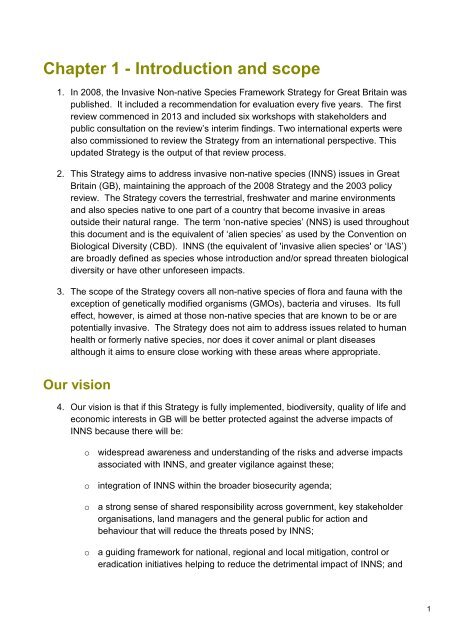The Great Britain Invasive Non-native Species Strategy
gb-non-native-species-strategy-pb14324
gb-non-native-species-strategy-pb14324
You also want an ePaper? Increase the reach of your titles
YUMPU automatically turns print PDFs into web optimized ePapers that Google loves.
Chapter 1 - Introduction and scope1. In 2008, the <strong>Invasive</strong> <strong>Non</strong>-<strong>native</strong> <strong>Species</strong> Framework <strong>Strategy</strong> for <strong>Great</strong> <strong>Britain</strong> waspublished. It included a recommendation for evaluation every five years. <strong>The</strong> firstreview commenced in 2013 and included six workshops with stakeholders andpublic consultation on the review’s interim findings. Two international experts werealso commissioned to review the <strong>Strategy</strong> from an international perspective. Thisupdated <strong>Strategy</strong> is the output of that review process.2. This <strong>Strategy</strong> aims to address invasive non-<strong>native</strong> species (INNS) issues in <strong>Great</strong><strong>Britain</strong> (GB), maintaining the approach of the 2008 <strong>Strategy</strong> and the 2003 policyreview. <strong>The</strong> <strong>Strategy</strong> covers the terrestrial, freshwater and marine environmentsand also species <strong>native</strong> to one part of a country that become invasive in areasoutside their natural range. <strong>The</strong> term ‘non-<strong>native</strong> species’ (NNS) is used throughoutthis document and is the equivalent of ‘alien species’ as used by the Convention onBiological Diversity (CBD). INNS (the equivalent of 'invasive alien species' or ‘IAS’)are broadly defined as species whose introduction and/or spread threaten biologicaldiversity or have other unforeseen impacts.3. <strong>The</strong> scope of the <strong>Strategy</strong> covers all non-<strong>native</strong> species of flora and fauna with theexception of genetically modified organisms (GMOs), bacteria and viruses. Its fulleffect, however, is aimed at those non-<strong>native</strong> species that are known to be or arepotentially invasive. <strong>The</strong> <strong>Strategy</strong> does not aim to address issues related to humanhealth or formerly <strong>native</strong> species, nor does it cover animal or plant diseasesalthough it aims to ensure close working with these areas where appropriate.Our vision4. Our vision is that if this <strong>Strategy</strong> is fully implemented, biodiversity, quality of life andeconomic interests in GB will be better protected against the adverse impacts ofINNS because there will be:o widespread awareness and understanding of the risks and adverse impactsassociated with INNS, and greater vigilance against these;o integration of INNS within the broader biosecurity agenda;o a strong sense of shared responsibility across government, key stakeholderorganisations, land managers and the general public for action andbehaviour that will reduce the threats posed by INNS;o a guiding framework for national, regional and local mitigation, control oreradication initiatives helping to reduce the detrimental impact of INNS; and1


